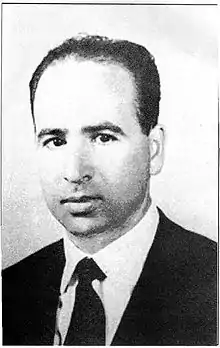Krim Belkacem
Krim Belkacem (September 14, 1922, Aït Yahia Moussa, Tizi Ouzou Province – October 18, 1970) was the historic leader of the National Liberation Front during the Algerian War. It is Krim Belkacem who will sign the act of independence of Algeria at the bottom of the Évian Accords as the most senior of the former guerrillas and the only member of the six who triggered the Red All-Saints' Day still alive and not a prisoner and as vice-president of the GPRA.
Krim Belkacem | |
|---|---|
 Photo of Krim Belkacem | |
| Born | September 14, 1922 |
| Died | October 18, 1970 (aged 48) Frankfurt, West Germany (Assassinated) |
| Nationality | Algerian |
| Other names | Si Rabah |
| Known for | Algerian war, Évian Accords |
| Signature | |
 | |
Biography
Krim was born in the village of Aït Yahia Moussa (now in Tizi Ouzou Province) in the Berber-speaking Kabylie region of Algeria. During the Second World War, he joined the French Army, and was promoted corporal in the First Algerian Sharpshooter Regiment, reputedly becoming an excellent shot.[1] Demobilized on October 4, 1945, he returned to his home village, where he took up a bureaucratic post. Krim joined the underground Algerian People's Party at the beginning of 1946, setting up clandestine cells in 12 villages around Draa el-Mizan.[1] Accused of the murder of a forest warden in 1947, he was hunted and he joined the maquis under the Pseudonym of Si Rabah with Moh Nachid, Mohand Talah and Messaoud Ben Arab. Twice sentenced to death by French tribunals in 1947 and 1950, he became the Kabylie responsible of the PPA-MTLD paramilitary organization founded in February 1947 by Messali Hadj, the Organisation Spéciale, at the head of 22 members of the resistance (maquisards).
During the Algerian War of Independence, Krim was chief of the FLN's 3rd Wilaya, Kabylie and its surrounding area. After his important role at the Soummam Congress—in which the FLN formalized its revolutionary program—Krim became one of the most important and powerful of all the FLN chiefs.[2] He was the first to be Minister of Defense, then Foreign Minister, in the provisional Government of the Algerian republic (GPRA) in 1958, and Vice President of Algeria.[3] Later he was the principal Algerian negotiator of the agreements of Évian in March 1962. Belkacem was in opposition to the creation of the Political Bureau of the FLN in July 1962 by Ahmed Ben Bella, Colonel Houari Boumedienne, and Mohamed Khider.
Political views and Assassination
After the coup d'état of June 19, 1965, he returned to the opposition. Accused of having organized an attack against Boumediene in April 1967, manipulated and betrayed by part of his entourage, he was sentenced to death in absentia.
According to her daughter Karima, in an interview with El Moudjahid on March 25, 1998, Belkacem definitively gave up politics in August 1967: "On August 4, 1967," she says, "he hastily packed his whole family with some effects in the family. Volkswagen and drive all night in to Morocco. The next day, he was sentenced in absentia ”. Then begins a bitter exile. On October 17, 1967, he created with friends including Slimane Amirat, Colonels Amar Ouamrane and Mohand Oulhadj, the Movement for the Defense of the Algerian Revolution (MDRA), an underground party intended to fight against the Boumediene regime. Two years later, on October 18, 1970, he was found strangled with his tie in a hotel room in Frankfurt, presumably by Algerian military security agents.[4]
See also
- Algerian war
- List of assassinated people
References
| Wikimedia Commons has media related to Krim Belkacem. |
- Cheurfi, Achour, La Classe Politique Algerienne, Casbah Editions, Alger, 2006 - p 230
- Cheurfi, Achour, La Classe Politique Algerienne, Casbah Editions, Alger, 2006 - p 231
- Ottaway, Professor Marina; Ottaway, David; Ottaway, Marina (December 15, 1970). "Algeria: The Politics of a Socialist Revolution". University of California Press – via Google Books.
- Martin Evans; John Phillips (1 January 2007). Algeria: Anger of the Dispossessed. Yale University Press. p. 81. ISBN 0-300-10881-8.
